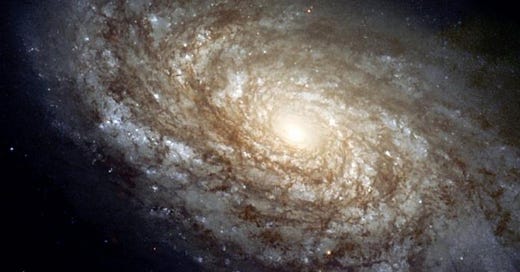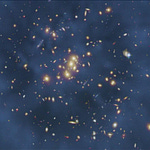Today we are going to talk about Big Bang theory, dark energy, and how Mills’s theory might resolve the modern crisis in cosmology.
Top takeaways:
“Dark energy” is the mysterious cause behind the accelerating expansion of the universe, discovered in 1997.
Randell Mills’s theory provides a means for spacetime to expand, and his cosmological theory, published in 1995, predicted dark energy.
Mills’s theory predicts an oscillating universe, explaining why structures exist that would predate the Big Bang.
Newton’s Universe
On the scale of stars and galaxies, the universe is governed by gravity. When Isaac Newton published Law of Universal Gravitation in 1687, it was unchallenged by any observations in nature save one: by the naked eye, stars do not move. They seem balanced in equilibrium. He likened it to an infinite number of needles poised upon their points. Why don’t the stars collapse into one another?
Gravitation was a law that applied on all scales, from the terrestrial scale of cannon balls to that of the moon, the planets, the rings of Saturn, and the paths of asteroids and comets. It was universal. The rational physics of the world acts with equal power over all things and with the same inevitability.
Late in life, he could only invoke a kind of divine intervention.
And so that the systems of the fixed stars will not fall upon one another as a result of their gravity, He has placed them at immense distances from one another.
Hubble’s Universe
When Galileo first looked through a telescope, he found that the band of light that crosses the night sky, our Milky Way, is made of innumerable stars. We now know the stars do move; they orbit the galaxy like the planets orbit the Sun.
In 1939 Edwin Hubble discovered that our galaxy is but one of innumerable others in the universe, and that these other galaxies are fantastically far away. But Newton’s dilemma still stands: why don’t the galaxies collapse into one another?
Hubble studied how the galaxies move. He used subtle shifts in the spectrum of light from galaxies. He found that almost all the galaxies we can see, in any direction we look, are moving away from us.
The entire universe is expanding. The farther away the galaxy is, the faster it is receding. This is Hubble’s Law. It is as if the space between us and the galaxies was inflating like a balloon.
Einstein’s Universe
Einstein’s Theory of General Relativity offered an important advance over Newton’s theory of gravity. While Newton believed gravity to be a force acting between two bodies, Einstein discovered that gravity it was not a force - at least not like the others, but rather it is a bending of space produced by mass. Objects fall toward one another because they are proceeding along straight lines through curved space. Even light—with no mass—is bent by gravity.
But Einstein’s theory, like Newton’s, predicted that galaxies ought to collapse in to one another. Until Hubble, the universe appeared to be in equilibrium, and in order to reconcile his theory with the observations of a static universe, he introduced a factor into his equations to correct this.
When Hubble found the universe to be expanding, Einstein slapped his forehead and lamented that this extra factor (called the “cosmological constant”) was a mistake. His theory would have predicted that the universe is either expanding, or collapsing. It couldn’t be static.
If the universe is expanding, where did it come from? A Belgian catholic priest and physicist, Georges Lemaître, speculated that the universe would have exploded from a point. Fred Hoyle, critical of the idea, inadvertently coined it in a BBC radio interview in 1948 as “one Big Bang.”
The Big Bang Universe
Big Bang theory is a narrative that contains a lot of unanswered questions. It suggests that the universe began as a giant fireball, that it overcame gravity and exploded into the void, and in doing so, seeded the nebulae, the stars, the galaxies, their sweeping arms of gas and dust tying them into the luminous fabric of the world.
The theory is supported by the observation that the universe is expanding. It is also supported by a prediction that there should be a ambient light in the universe at a specific temperature, left over from the Big Bang. This is called the “cosmic microwave background” radiation.
We are also able to observe into the universe’s distant past. In long exposures of otherwise dark regions of space, we are able to see light from galaxies billions of light-years away. The farther we look, the further back in time we see, like paging backwards through a photo album. In the early childhood of the universe, we see a higher percentage of youthful galaxies.
Based on these fact, the Big Bang is accepted by the majority of physicists as the best explanation of the origin and evolution of the universe. However, the theory is starting to break down under the weight of new evidence.
Hubble Strikes Again
By the fall of 1997, two teams used the Hubble Space Telescope to determine how fast the universe was expanding since the Big Bang. Obviously, the universe would be slowing down as it expands; and they wanted to know whether the universe would collapse in on itself again, or coast outward forever.
The results were stunning. The universe was not decelerating. It was accelerating outward. This makes no sense according to Big Bang theory. The universe could not simply be coasting outward from an explosion. Something was pushing it out.
In the wake of the discovery of the accelerating universe, theoreticians picked up Einstein's equations for General Relativity, and on the line where Einstein had erased his cosmological constant, they scribbled it back in again. It was still unexplained, but this didn't stop physicists from calling Einstein a genius once again, prescient even in his errors.
As to the phenomenon causing the expansion of the universe? Astronomers called it “dark energy.” ‘Dark’ because, well, it was mysterious. And whatever it was, there was a lot of it.
The Universe According to JWST
Aided by the James Webb Space Telescope (JWST) launched in 2021, astronomers can now look very far back into the early universe.
Where they expect to see very young galaxies, they have instead found giant, ancient structures such as supermassive black holes, flourishing only 500 million years after the Big Bang. This is crazy: black holes are the remains of massive stars and can only grow large after billions of years of the slow accretion of matter.
Astrophysicists are trying to get around this, in theory, and have proposed that the Big Bang “seeded” black holes. But the cosmic background radiation suggests that the Big Bang should have produced an even distribution of matter, not large clumps.
When scientists encounter disconfirming evidence, their first instinct is to find a way to account for it within the limitations of the accepted theory. This is the normal process of science, but it means that a theory often survives long past its expiration date and becomes a hodgepodge of corrections.
Mills’s Universe
In the early 1990’s, before the discovery of “dark energy,” Randell Mills expanded his new model for fundamental particles to a new theory of gravity, slightly modifying Einstein’s theory. It allowed him to do a lot of useful work, such as calculate masses of particles, which we will talk about another time.
One seminal result of his new theory was the following: When a particle is born (when energy is converted into matter) spacetime around the particle contracts, it gets sucked in. This bends space, creating gravity. When the reverse happens, when a particle dies (when matter is converted into energy) spacetime expands, pushing out again. Overall, spacetime is conserved.
Mills quantified this in an equation. The energy required to produce 1 second of spacetime expansion is: c3 / 4 π G . This value is enormous, 3.22 x 1034 kg. That’s thirty four zeroes on the end. It is 16,000 times the mass of our Sun. It takes the combined power output of the entire universe, for about 40 seconds, to produce 1 second of expansion.
Any event that creates matter contracts spacetime; any event that releases matter expands spacetime.
And it is an epiphany.
Look up at the night sky, and what do you see? Small glimmering dots. Stars are the universe’s factories, enormous fusion engines that turn matter into starlight. When atoms fuse, they lose a little bit of mass. In this way our Sun, a modest yellow dwarf, loses about 4 billion kilograms of mass every second, releasing this as light.
According to Mills’s theory every fusion event must push out space a little bit. There are hundreds of billions of stars in our galaxy alone, and hundreds of billions of galaxies in the universe.
Mills realized that the universe is not simply coasting outward from the Big Bang, but actively pushing itself out. Stellar fusion, the most abundant physical process in nature, provides an explains the expansion of the universe.
Extrapolating billions of years into the future, Mills’s theory tells us that the fires of the universe will continue to burn, expanding space, pushing galaxies apart from one another on the spacetime wind. But this will not last forever.
Suppose that we could accelerate time and watch the unfolding of the fate of the universe from Earth.
Within a blink of an eye, Man will have disappeared. A billion years from now, the Sun - which is about halfway through its 10 billion year life, and increasingly luminous, will become too hot for Earth to support complex life.
In about 5 billion years, it will inflate to a red giant and throw material out into space, leaving behind a white dwarf, which will cool slowly in retirement.
Around the same time, the Milky Way galaxy will merge with the Andromeda Galaxy in a beautiful dance. During this collision, the space between stars will be reinvigorated, congealing gas and dust and the debris from dead stars into new ones, which will begin their own life cycles.
Stars larger than our Sun burn through their fuel more quickly. Many will go supernova, forming stellar remnants such as white dwarfs, neutron stars, or black holes.
Perhaps 50 billion years from now, the generation of giants will be over. The galaxy will enter an era of dwarf stars smaller than our Sun. These burn their fuel more slowly. These, such as red dwarfs are, in fact, the majority of the stars, and they are expected to steadily increase in luminosity over time, keeping the galaxy bright far into the future even after the giants have gone.
These stars burn so slowly that they could last tens of trillions of years. But they will fail far sooner. There is another processes at work, exhausting their fuel.
The hydrino reaction, which converts normal hydrogen into tightly bound hydrino states, creating the dark matter in the universe, will draw the electrons ever tighter, until they cause proton decay. This is happening all the time, both inside stars as well as throughout the giant clouds of gas that surround galaxies.
After hundreds of billions of years, matter becomes scarce. The heavier elements in ash of stars undergo radioactive decay. Stellar remnants would collide and merge to form black holes, which would feed on other stars until they grow fat. Another consequence of Mills’s theory is that black holes inevitably annihilate in violent bursts of gamma rays.
There is a chilly emptiness as galaxies shrink and go dark. The last surviving dwarf stars would be lonely outposts, wavering dim candles in a vast expanse.
Since the expansion of the universe is driven by the release of matter as light, the universe, which accelerated during its vigor, is now decelerating in its expansion. Eventually, it will stop. The universe has reached its maximum size: about 8 trillion light years across.
After a pause, the tide would turn.
The universe, large and empty, filled with light, will begin to form new particles. Most new particles would be neutrons, which decay quickly into protons and electrons, the building blocks of hydrogen gas.
Each spark of new matter contracts space and exert gravity on its surroundings; the particles would combine into atoms and molecules, giving mass to the gathering clouds. The universe would begin to shrink.
Slowly at first, then faster, the universe accelerates inward until it reaches a rapid pace. New fires would kindle as new stars feed on fresh supplies of hydrogen gas. These will form massive stars that eventually go supernova and form black holes; the seeds of new galaxies.
Although stars are once again shining, it does little to slow the implosion now occurring across billions of light years of space.
Only after murky unformed clouds form young galaxies and begin to take shape as ellipses and spirals; only after they are once again neighbors, occasionally colliding, and grouping into clusters and superclusters; only once they are fully ablaze and the heavens are filled with light, would the universe stop shrinking and pause.
Galaxies would again be mature, dense, and hot. Millions of new stars would be born every day. The universe would start to expand, slowly at first, then faster, pushing itself outward once again on the spacetime wind. We have come full circle.
We find ourselves on a small rocky planet orbiting a yellow dwarf star about 14 billion years after the start of the expansion. This is only 3% into the expansion cycle; in a 400-page book, we are only on page 12. Our universe is still accelerating in its outward expansion, fueled by starlight.
Mills’s universe expands and contracts, in an oscillating cycle that has a period of about one trillion years. And it will do so for all time—forever.
Non Ex Nihilo
Many have felt that the universe must have come from somewhere, from a prime mover. But science tells us that the universe has always been. If we disregard the Big Bang as scientific fiction, do we dismiss, finally, arguments for a Creator?
Perhaps our beliefs will evolve as they have been forced to do before, when man discovered that he was not the center of the universe, or when he discovered that he was only one branch on the tree of life. Instead of a creation, there is only a continuum of change; instead of a creator, there is only a custodian of time.
When we look to the heavens for the prime mover, we find only light and matter responsible for the rhythm of the universe, the ebb and flow that gives and takes life.
Perhaps what makes our place in the universe meaningful is simply that we are here to perceive it. Our meaning is derived from the beauty and experience of our lives, our activities, our advances in knowledge and art, our relationships, our happiness in a moment, as we gaze up at the stars. We are here now, partaking in its majesty for a moment, before the death throes of dark stars, a hundred billion years from now, finally extinguish all our works.
Whatever the fate of our race, the universe will go on, and after coldness and darkness refold on itself, new planets will emerge kindling new life.
Other beings, at other times, may look out and see a contracting universe. Like us, they will wonder why. Most confused, perhaps, will be those who live at the inflection point; the pause at the beginning of the cycle. They will look out and see a static universe, balanced as if on the head of a pin.
Thoughts and questions? Join the conversation!
For further reading, this topic is covered in the forthcoming book: The End of Fire: Hydrino Energy and the Future of Physics by Brett Holverstott.
Background music attribution:
Signal To Noise by Scott Buckley | Music promoted by Free Stock Music | Creative Commons / Attribution 4.0 International (CC BY 4.0)













Share this post